Evaluation of Soil Quality and Maize Growth in Different Profiles of Reclaimed Land with Coal Gangue Filling
Abstract
:1. Introduction
2. Materials and Methods
2.1. Experimental Sites
2.2. Sampling and Analysis
2.3. Statistical Analyses
2.4. Soil Quality Assessment Methods
3. Results
3.1. Selection of Soil Quality Indicators
3.2. Feature of MDS
3.3. Weight Calculation
3.4. Soil Quality Assessment
3.5. Agronomic Traits of Maize under Different Profile Configurations
4. Discussion
4.1. Impact Factors to Physical and Chemical Properties of Surface Soil
4.2. Correlation between Agronomic Traits of Maize and Properties of Surface Soil
4.3. Design of CG Filling and Reclamation Profile
5. Conclusions
Author Contributions
Funding
Institutional Review Board Statement
Informed Consent Statement
Data Availability Statement
Acknowledgments
Conflicts of Interest
References
- Burke, R.A.; Fritz, K.M.; Barton, C.D.; Johnson, B.R.; Fulton, S.; Hardy, D.; Word, D.A.; Jack, J.D. Impacts of mountaintop removal and valley fill coal mining on C and N processing in terrestrial soils and headwater streams. Water Air Soil Pollut. 2014, 225, 1–17. [Google Scholar] [CrossRef]
- Wang, J.; Qin, Q.; Hu, S.; Wu, K. A concrete material with waste coal gangue and fly ash used for farmland drainage in high groundwater level areas. J. Clean. Prod. 2016, 112, 631–638. [Google Scholar] [CrossRef]
- Haibin, L.; Zhenling, L. Recycling utilization patterns of coal mining waste in China. Resour. Conserv. Recycl. 2010, 54, 1331–1340. [Google Scholar] [CrossRef]
- Yu, L.J.; Feng, Y.L.; Yan, W. The current situation of comprehensive utilization of coal gangue in China. Adv. Mater. Res. 2012, 524–527, 915–918. [Google Scholar] [CrossRef]
- Qi, J.; Hu, Z.; Zhou, J. Environmental implications of waste coal back-fillings for land reclamation in coal mine areas with shallow water table. China Coal 2002, 10, 39–41. (In Chinese) [Google Scholar] [CrossRef]
- Xuan, L.; Wenkai, L.; Hebing, Z.; Haipeng, N. Comprehensive landscape ecology stability assessment of a coal gangue backfill reclamation area. Pol. J. Environ. Stud. 2016, 25, 1305–1314. [Google Scholar] [CrossRef]
- Tan, W.-F.; Wang, L.-A.; Huang, C. Environmental effects of coal gangue and its utilization. Energy Sources Part A Recovery Util. Environ. Eff. 2016, 38, 3716–3721. [Google Scholar] [CrossRef]
- Obade, V.D.P.; Lal, R. Science of the Total Environment A standardized soil quality index for diverse field conditions. Sci. Total Environ. 2016, 541, 424–434. [Google Scholar] [CrossRef]
- De Paul Obade, V.; Lal, R. Using meta-analyses to assess pedo-variability under different land uses and soil management in central Ohio, USA. Geoderma 2014, 232–234, 56–68. [Google Scholar] [CrossRef]
- Liu, Z.; Zhou, W.; Shen, J.; Li, S.; Ai, C. Soil quality assessment of yellow clayey paddy soils with different productivity. Biol. Fertil. Soils 2014, 50, 537–548. [Google Scholar] [CrossRef]
- Mueller, L.; Schindler, U.; Shepherd, T.G.; Ball, B.C.; Smolentseva, E.; Hu, C.; Hennings, V.; Schad, P.; Rogasik, J.; Zeitz, J.; et al. A framework for assessing agricultural soil quality on a global scale. Arch. Agron. Soil Sci. 2012, 58, S76–S82. [Google Scholar] [CrossRef]
- Chahal, I.; Van Eerd, L.L. Quantifying soil quality in a horticultural-cover cropping system. Geoderma 2019, 352, 38–48. [Google Scholar] [CrossRef]
- Shi, Z.; Bai, Z.; Guo, D.; Chen, M. Develop a Soil Quality Index to Study the Results of Black Locust on Soil Quality below Different Allocation Patterns. Land 2021, 10, 785. [Google Scholar] [CrossRef]
- D’Hose, T.; Cougnon, M.; De Vliegher, A.; Vandecasteele, B.; Viaene, N.; Cornelis, W.; Van Bockstaele, E.; Reheul, D. The positive relationship between soil quality and crop production: A case study on the effect of farm compost application. Appl. Soil Ecol. 2014, 75, 189–198. [Google Scholar] [CrossRef]
- Salvati, L.; Ferrara, C.; Corona, P. Indirect validation of the Environmental Sensitive Area Index using soil degradation indicators: A country-scale approach. Ecol. Indic. 2015, 57, 360–365. [Google Scholar] [CrossRef]
- Stone, D.; Costa, D.; Daniell, T.J.; Mitchell, S.M.; Topp, C.F.E.; Griffiths, B.S. Using nematode communities to test a European scale soil biological monitoring programme for policy development. Appl. Soil Ecol. 2016, 97, 78–85. [Google Scholar] [CrossRef]
- Kibblewhite, M.G. Definition of priority areas for soil protection at a continental scale. Soil Use Manag. 2012, 28, 128–133. [Google Scholar] [CrossRef]
- Bünemann, E.K.; Bongiorno, G.; Bai, Z.; Creamer, R.E.; De Deyn, G.; de Goede, R.; Fleskens, L.; Geissen, V.; Kuyper, T.W.; Mäder, P.; et al. Soil quality—A critical review. Soil Biol. Biochem. 2018, 120, 105–125. [Google Scholar] [CrossRef]
- Juhos, K.; Czigány, S.; Madarász, B.; Ladányi, M. Interpretation of soil quality indicators for land suitability assessment—A multivariate approach for Central European arable soils. Ecol. Indic. 2019, 99, 261–272. [Google Scholar] [CrossRef]
- Chen, J.; Qu, M.; Zhang, J.; Xie, E.; Huang, B.; Zhao, Y. Soil fertility quality assessment based on geographically weighted principal component analysis (GWPCA) in large-scale areas. Catena 2021, 201, 105197. [Google Scholar] [CrossRef]
- Vasu, D.; Singh, S.K.; Ray, S.K.; Duraisami, V.P.; Tiwary, P.; Chandran, P.; Nimkar, A.M.; Anantwar, S.G. Soil quality index (SQI) as a tool to evaluate crop productivity in semi-arid Deccan plateau, India. Geoderma 2016, 282, 70–79. [Google Scholar] [CrossRef]
- Andrés-Abellán, M.; Wic-Baena, C.; López-Serrano, F.R.; García-Morote, F.A.; Martínez-García, E.; Picazo, M.I.; Rubio, E.; Moreno-Ortego, J.L.; Bastida-López, F.; García-Izquierdo, C. A soil-quality index for soil from Mediterranean forests. Eur. J. Soil Sci. 2019, 70, 1001–1011. [Google Scholar] [CrossRef]
- Calzolari, C.; Ungaro, F.; Filippi, N.; Guermandi, M.; Malucelli, F.; Marchi, N.; Staffilani, F.; Tarocco, P. A methodological framework to assess the multiple contributions of soils to ecosystem services delivery at regional scale. Geoderma 2016, 261, 190–203. [Google Scholar] [CrossRef]
- Lam, S.K.; Chen, D.; Norton, R.; Armstrong, R.; Mosier, A.R. Nitrogen dynamics in grain crop and legume pasture systems under elevated atmospheric carbon dioxide concentration: A meta-analysis. Glob. Chang. Biol. 2012, 18, 2853–2859. [Google Scholar] [CrossRef]
- Roy, A.K.; Wagner-Riddle, C.; Deen, B.; Lauzon, J.; Bruulsema, T. Nitrogen application rate, timing and history effects on nitrous oxide emissions from corn (Zea mays L.). Can. J. Soil Sci. 2014, 94, 563–573. [Google Scholar] [CrossRef] [Green Version]
- Gregorich, E.; Janzenx, H.H.; Helgason, B.; Ellert, B. Nitrogenous Gas Emissions from Soils and Greenhouse Gas Effects. Adv. Agron. 2015, 132, 39–74. [Google Scholar] [CrossRef]
- Guan, Q.; Wang, F.; Xu, C.; Pan, N.; Lin, J.; Zhao, R.; Yang, Y.; Luo, H. Source apportionment of heavy metals in agricultural soil based on PMF: A case study in Hexi Corridor, northwest China. Chemosphere 2018, 193, 189–197. [Google Scholar] [CrossRef]
- Yang, C.; Fan, Z.; Chai, Q. Agronomic and Economic Benefits of Pea/Maize Intercropping Systems in Relation to N Fertilizer and Maize Density. Agronomy 2018, 8, 52. [Google Scholar] [CrossRef] [Green Version]
- Chukwudi, U.P.; Kutu, F.R.; Mavengahama, S. Influence of Heat Stress, Variations in Soil Type, and Soil Amendment on the Growth of Three Drought–Tolerant Maize Varieties. Agronomy 2021, 11, 1485. [Google Scholar] [CrossRef]
- Widowati; Sutoyo; Karamina, H.; Fikrinda, W. Soil amendment impact to soil organic matter and physical properties on the three soil types after second corn cultivation. AIMS Agric. Food 2020, 5, 150–168. [Google Scholar] [CrossRef]
- Fang, J.; Su, Y. Effects of Soils and Irrigation Volume on Maize Yield, Irrigation Water Productivity, and Nitrogen Uptake. Sci. Rep. 2019, 9, 1–11. [Google Scholar] [CrossRef]
- Van Es, H.M.; Yang, C.L.; Geohring, L.D. Maize Nitrogen Response as Affected by Soil Type and Drainage Variability. Precis. Agric. 2005, 6, 281–295. [Google Scholar] [CrossRef]
- Akinyele, B.O.; Adigun, A.B. Soil Texture and the Phenotypic Expression of Maize (Zea mays L.). Res. J. Bot. 2006, 1, 139–143. [Google Scholar] [CrossRef]
- Kwon, S.J.; Kim, H.R.; Roy, S.K.; Kim, H.J.; Boo, H.O.; Woo, S.H.; Kim, H.H. Effects of Nitrogen, Phosphorus and Potassium Fertilizers on Growth Characteristics of Two Species of Bellflower (Platycodon grandiflorum). J. Crop Sci. Biotechnol. 2019, 22, 481–487. [Google Scholar] [CrossRef]
- Liu, C.A.; Jin, S.L.; Zhou, L.M.; Jia, Y.; Li, F.M.; Xiong, Y.C.; Li, X.G. Effects of plastic film mulch and tillage on maize productivity and soil parameters. Eur. J. Agron. 2009, 31, 241–249. [Google Scholar] [CrossRef]
- Zhang, S.; Lövdahl, L.; Grip, H.; Tong, Y.; Yang, X.; Wang, Q. Effects of mulching and catch cropping on soil temperature, soil moisture and wheat yield on the Loess Plateau of China. Soil Tillage Res. 2009, 102, 78–86. [Google Scholar] [CrossRef]
- Zhang, W.; Xu, M.; Wang, B.; Wang, X. Soil organic carbon, total nitrogen and grain yields under long-term fertilizations in the upland red soil of southern China. Nutr. Cycl. Agroecosystems 2008, 84, 59–69. [Google Scholar] [CrossRef]
- Zhang, Y.; Han, H.; Zhang, D.; Li, J.; Gong, X.; Feng, B.; Xue, Z.; Yang, P. Effects of ridging and mulching combined practices on proso millet growth and yield in semi-arid regions of China. Field Crop. Res. 2017, 213, 65–74. [Google Scholar] [CrossRef]
- Zhang, Z.; Whish, J.P.M.; Bell, L.W.; Nan, Z. Forage production, quality and water-use-efficiency of four warm-season annual crops at three sowing times in the Loess Plateau region of China. Eur. J. Agron. 2017, 84, 84–94. [Google Scholar] [CrossRef]
- Wang, Y.; Wang, C.; Zhang, Q. Synergistic effects of climatic factors and drought on maize yield in the east of Northwest China against the background of climate change. Theor. Appl. Climatol. 2021, 143, 1017–1033. [Google Scholar] [CrossRef]
- Fang, L.; Xinju, L.; Le, H.; Anran, S. A long-term study on the soil reconstruction process of reclaimed land by coal gangue filling. Catena 2020, 195, 104874. [Google Scholar] [CrossRef]
- Zhang, K.; Xu, L.J.; Huang, G.D.; Meng, X.Y.; Yao, J.X.; Jiang, B.X. Coupled variations of soil temperature and moisture in reclaimed fields filled with coal gangue of different grain size distributions. J. Soils Sediments 2020, 20, 2248–2259. [Google Scholar] [CrossRef]
- Liu, L.W. Formation and evolution of Vertisols in Huaibei Plain. Pedosphere 1991, 1, 3–15. (In Chinese) [Google Scholar]
- Liu, J.; Wu, L.; Chen, D.; Yu, Z.; Wei, C. Development of a soil quality index for Camellia oleifera forestland yield under three different parent materials in Southern China. Soil Tillage Res. 2018, 176, 45–50. [Google Scholar] [CrossRef]
- Tian, Y.; Xin, J.; Ren, Y. NY/T 1121.2-2006: Soil Testing Part 2: Method for Determination of Soil pH; Ministry of Agriculture and Rural Affairs of the People’s Republic of China: Beijing, China, 2006.
- Zhou, F.; Zhang, W.; Yang, G. LY/T1251-1999: Analysis Methods of Water Soluble Salts of Forest Soil; National Forestry and Grassland Administration: Beijing, China, 1999.
- Ren, Y.; Xin, J.; Tian, Y. NY/T1121.6-2006: Soil Testing Part 6: Method for Determination of Soil Organic Matter; Ministry of Agriculture and Rural Affairs of the People’s Republic of China: Beijing, China, 2006.
- Jiao, R.; Dong, Y.; Sun, Q. LY/T 1228-2015: Nitrogen Determination Methods of Forest Soils; National Forestry and Grassland Administration: Beijing, China, 2015.
- Jiao, R.; Dong, Y.; Sun, Q. LY/T 1232-2015: Phosphorus Determination Methods of Forest Soils; National Forestry and Grassland Administration: Beijing, China, 2015.
- Jiao, R.; Dong, Y.; Sun, Q. LY/T 1234-2015: Potassium Determination Methods of Forest Soils; National Forestry and Grassland Administration: Beijing, China, 2015.
- Raiesi, F. A minimum data set and soil quality index to quantify the effect of land use conversion on soil quality and degradation in native rangelands of upland arid and semiarid regions. Ecol. Indic. 2017, 75, 307–320. [Google Scholar] [CrossRef]
- Brejda, J.J.; Moorman, T.B.; Karlen, D.L.; Dao, T.H. Identification of Regional Soil Quality Factors and Indicators I. Central and Southern High Plains. Soil Sci. Soc. Am. J. 2000, 64, 2115–2124. [Google Scholar] [CrossRef]
- Zuber, S.M.; Behnke, G.D.; Nafziger, E.D.; Villamil, M.B. Multivariate assessment of soil quality indicators for crop rotation and tillage in Illinois. Soil Tillage Res. 2017, 174, 147–155. [Google Scholar] [CrossRef]
- Ilarslan, R.; Kaya, Z.; Kandemir, I.; Bretting, P.K. Genetic variability among Turkish pop, flint and dent corn (Zea mays L. spp. mays) races: Morphological and agronomic traits. Euphytica 2002, 128, 173–182. [Google Scholar] [CrossRef]
- Andrews, S.S.; Karlen, D.L.; Mitchell, J.P. A comparison of soil quality indexing methods for vegetable production systems in Northern California. Agric. Ecosyst. Environ. 2002, 90, 25–45. [Google Scholar] [CrossRef]
- Wang, L.; Wang, F.; Wang, S.; Huang, Y.; Zhang, Z.; Bai, Z.; Cao, Y. Analysis of differences in chemical properties of reconstructed soil under different proportions of topsoil substitute materials. Environ. Sci. Pollut. Res. 2021, 28, 31230–31245. [Google Scholar] [CrossRef]
- Andrews, S.S.; Karlen, D.L.; Cambardella, C.A. The Soil Management Assessment Framework. Soil Sci. Soc. Am. J. 2004, 68, 1945–1962. [Google Scholar] [CrossRef]
- Navas, M.; Benito, M.; Rodríguez, I.; Masaguer, A. Effect of five forage legume covers on soil quality at the Eastern plains of Venezuela. Appl. Soil Ecol. 2011, 49, 242–249. [Google Scholar] [CrossRef]
- Li, Y.; Dong, S.; Wen, L.; Wang, X.; Wu, Y. Assessing the soil quality of alpine grasslands in the Qinghai-Tibetan Plateau using a modified soil quality index. Environ. Monit. Assess. 2013, 185, 8011–8022. [Google Scholar] [CrossRef] [PubMed]
- Zhang, G.; Bai, J.; Xi, M.; Zhao, Q.; Lu, Q.; Jia, J. Soil quality assessment of coastal wetlands in the Yellow River Delta of China based on the minimum data set. Ecol. Indic. 2016, 66, 458–466. [Google Scholar] [CrossRef] [Green Version]
- Wang, Z.; Chang, A.C.; Wu, L.; Crowley, D. Assessing the soil quality of long-term reclaimed wastewater-irrigated cropland. Geoderma 2003, 114, 261–278. [Google Scholar] [CrossRef]
- Mandal, U.K.; Warrington, D.N.; Bhardwaj, A.K.; Bar-Tal, A.; Kautsky, L.; Minz, D.; Levy, G.J. Evaluating impact of irrigation water quality on a calcareous clay soil using principal component analysis. Geoderma 2008, 144, 189–197. [Google Scholar] [CrossRef]
- Yao, R.J.; Yang, J.S.; Zhang, T.J.; Gao, P.; Yu, S.P.; Wang, X.P. Short-term effect of cultivation and crop rotation systems on soil quality indicators in a coastal newly reclaimed farming area. J. Soils Sediments 2013, 13, 1335–1350. [Google Scholar] [CrossRef]
- Liebig, M.A.; Varvel, G.; Doran, J. A simple performance-based index for assessing multiple agroecosystem functions. Agron. J. 2001, 93, 313–318. [Google Scholar] [CrossRef] [Green Version]
- Masto, R.E.; Chhonkar, P.K.; Singh, D.; Patra, A.K. Alternative soil quality indices for evaluating the effect of intensive cropping, fertilisation and manuring for 31 years in the semi-arid soils of India. Environ. Monit. Assess. 2008, 136, 419–435. [Google Scholar] [CrossRef]
- Bhardwaj, A.K.; Jasrotia, P.; Hamilton, S.K.; Robertson, G.P. Ecological management of intensively cropped agro-ecosystems improves soil quality with sustained productivity. Agric. Ecosyst. Environ. 2011, 140, 419–429. [Google Scholar] [CrossRef]
- Vinhal-Freitas, I.C.; Corrêa, G.F.; Wendling, B.; Bobuľská, L.; Ferreira, A.S. Soil textural class plays a major role in evaluating the effects of land use on soil quality indicators. Ecol. Indic. 2017, 74, 182–190. [Google Scholar] [CrossRef]
- Raiesi, F.; Kabiri, V. Identification of soil quality indicators for assessing the effect of different tillage practices through a soil quality index in a semi-arid environment. Ecol. Indic. 2016, 71, 198–207. [Google Scholar] [CrossRef]
- Wang, X.; Zhao, Y.; Liu, H.; Xiao, W.; Chen, S. Evaluating the water holding capacity of multilayer soil profiles using hydrus-1d and multi-criteria decision analysis. Water 2020, 12, 773. [Google Scholar] [CrossRef]
- Wang, Y.; Li, Y.; Wang, X.; Chau, H.W. Finger Flow Development in Layered Water-Repellent Soils. Vadose Zone J. 2018, 17, 170171. [Google Scholar] [CrossRef] [Green Version]
- Beibei, Z.; Ming’An, S.; Mingxia, W.; Quanjiu, W.; Horton, R. Effects of coal gangue content on water movement and solute transport in a China Loess plateau soil. Clean Soil Air Water 2010, 38, 1031–1038. [Google Scholar] [CrossRef]
- Nabiollahi, K.; Taghizadeh-Mehrjardi, R.; Kerry, R.; Moradian, S. Assessment of soil quality indices for salt-affected agricultural land in Kurdistan Province, Iran. Ecol. Indic. 2017, 83, 482–494. [Google Scholar] [CrossRef]
- Biswas, S.; Hazra, G.C.; Purakayastha, T.J.; Saha, N.; Mitran, T.; Singha Roy, S.; Basak, N.; Mandal, B. Establishment of critical limits of indicators and indices of soil quality in rice-rice cropping systems under different soil orders. Geoderma 2017, 292, 34–48. [Google Scholar] [CrossRef]
- An, N.; Wei, W.; Qiao, L.; Zhang, F.; Christie, P.; Jiang, R.; Dobermann, A.; Goulding, K.W.T.; Fan, J.; Fan, M. Agronomic and environmental causes of yield and nitrogen use efficiency gaps in Chinese rice farming systems. Eur. J. Agron. 2018, 93, 40–49. [Google Scholar] [CrossRef]
- Singh, V.K.; Kumar, D.; Kashyap, P.S.; Singh, P.K.; Kumar, A.; Singh, S.K. Modelling of soil permeability using different data driven algorithms based on physical properties of soil. J. Hydrol. 2020, 580, 124223. [Google Scholar] [CrossRef]
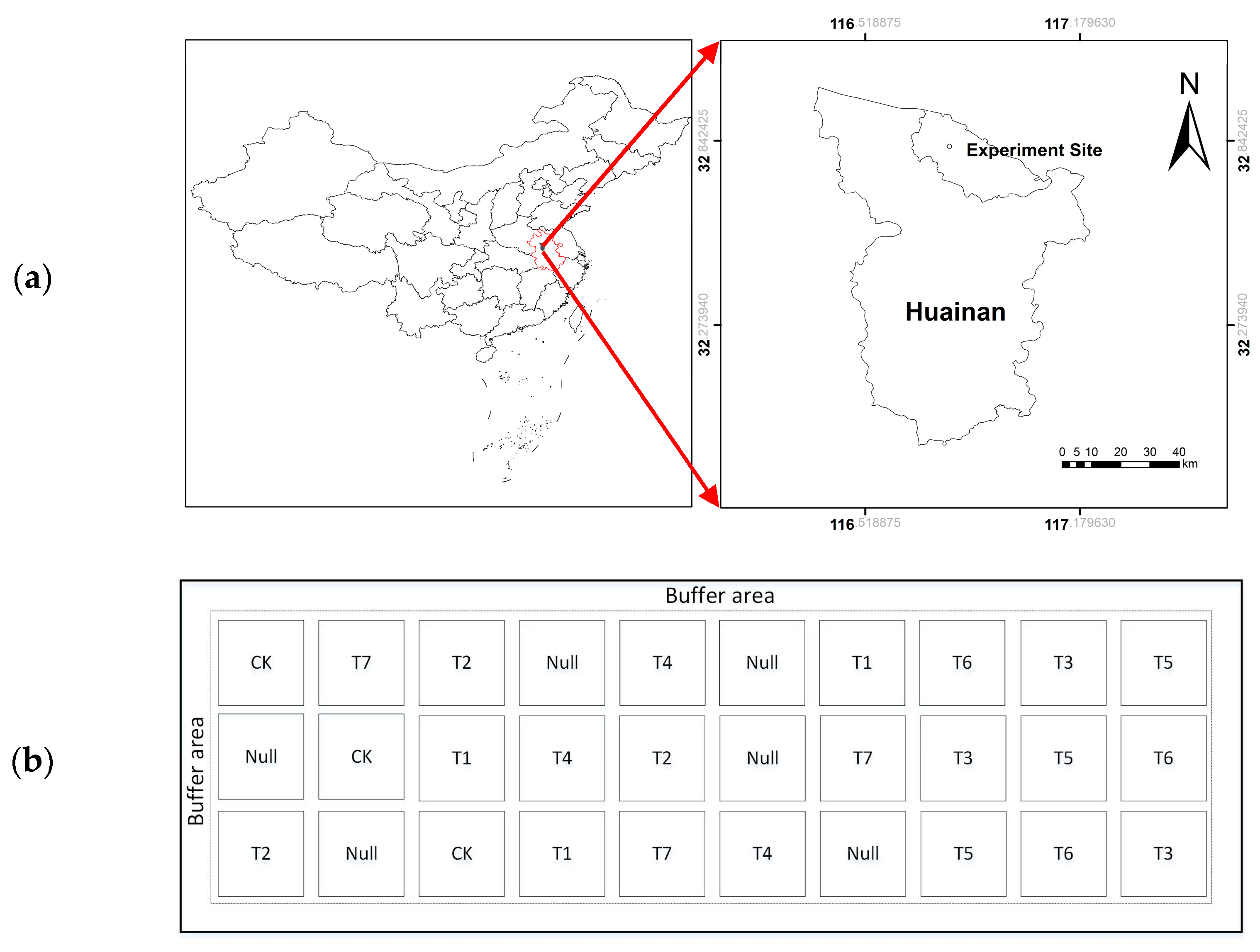
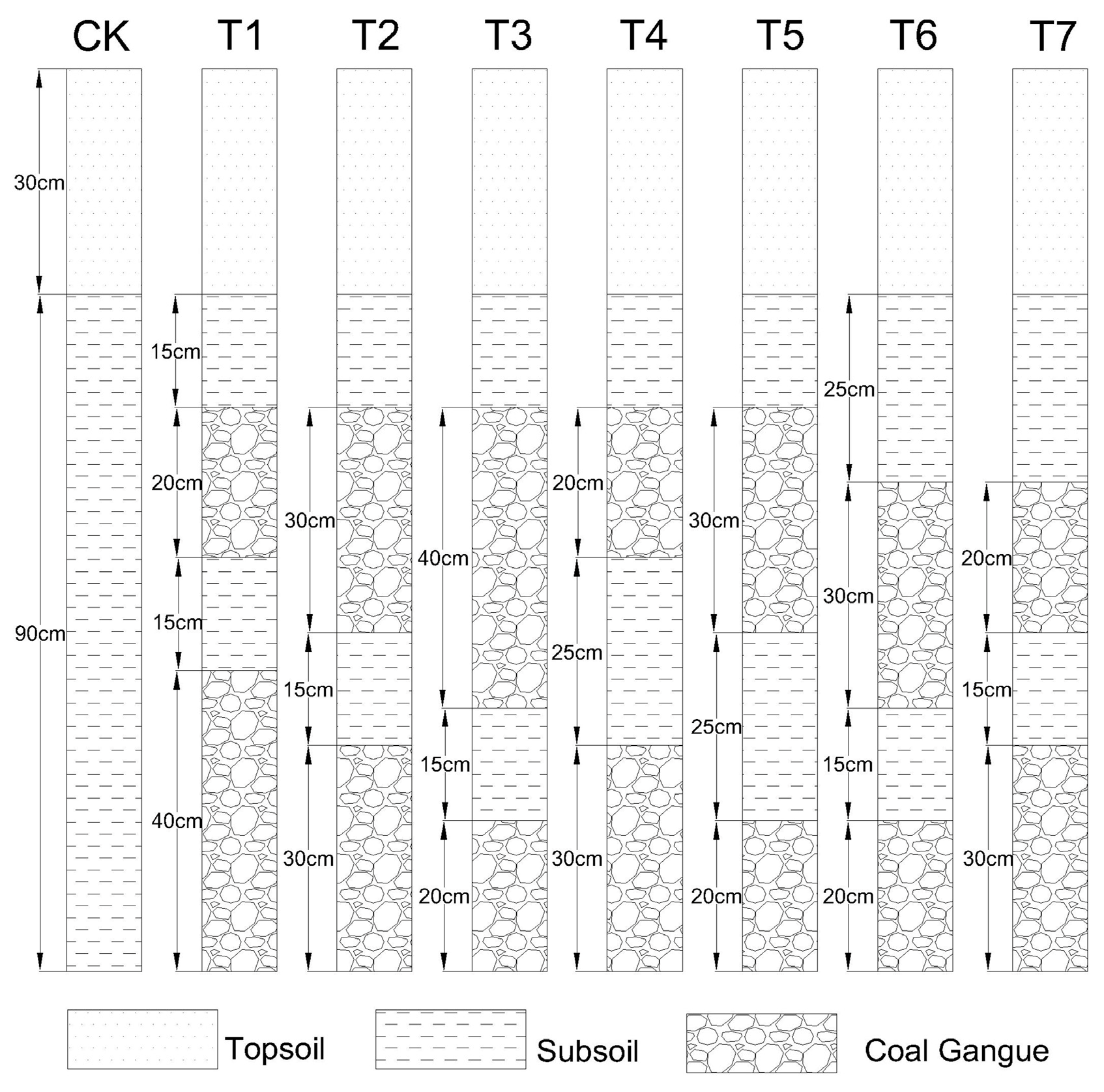
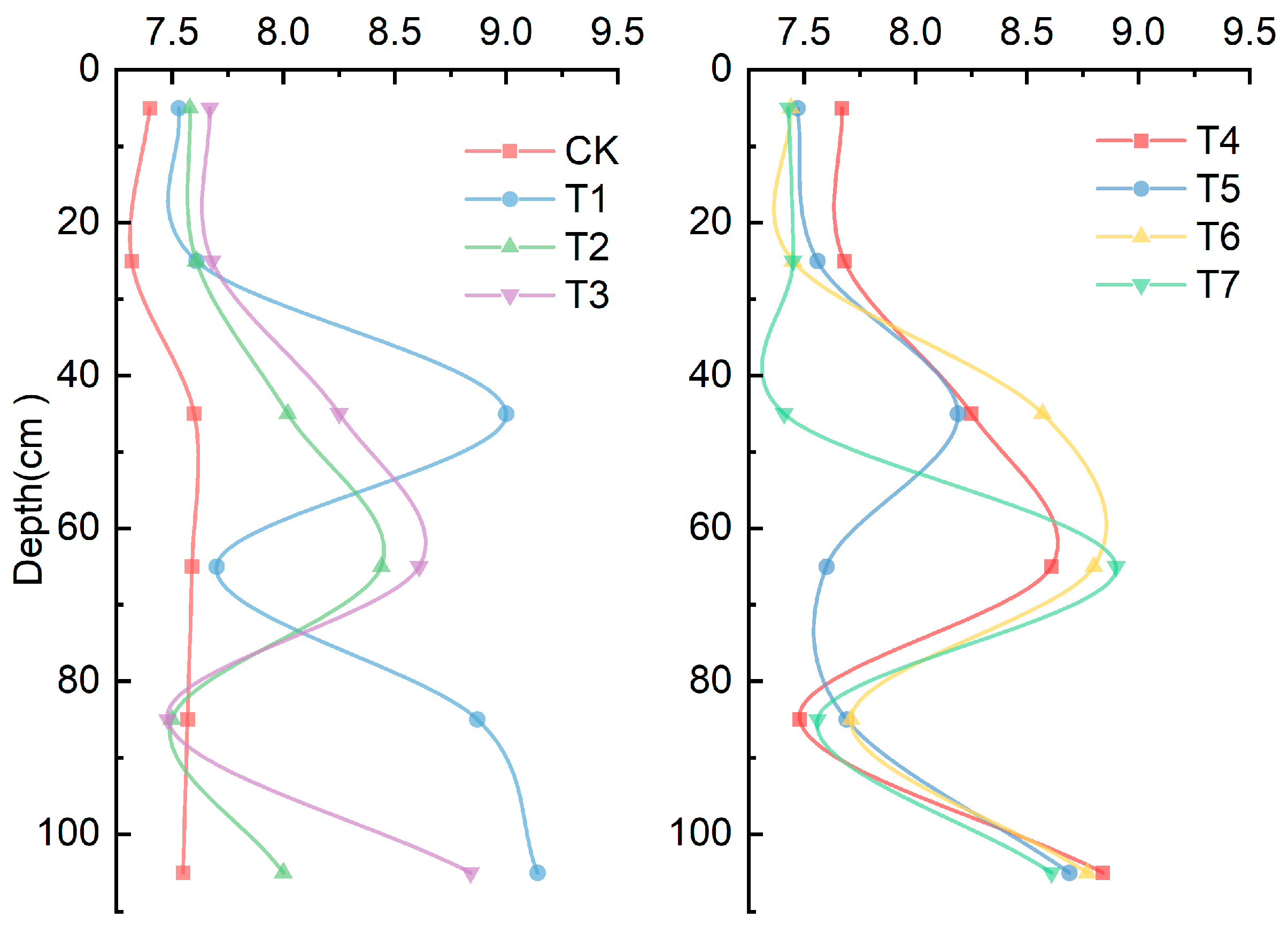

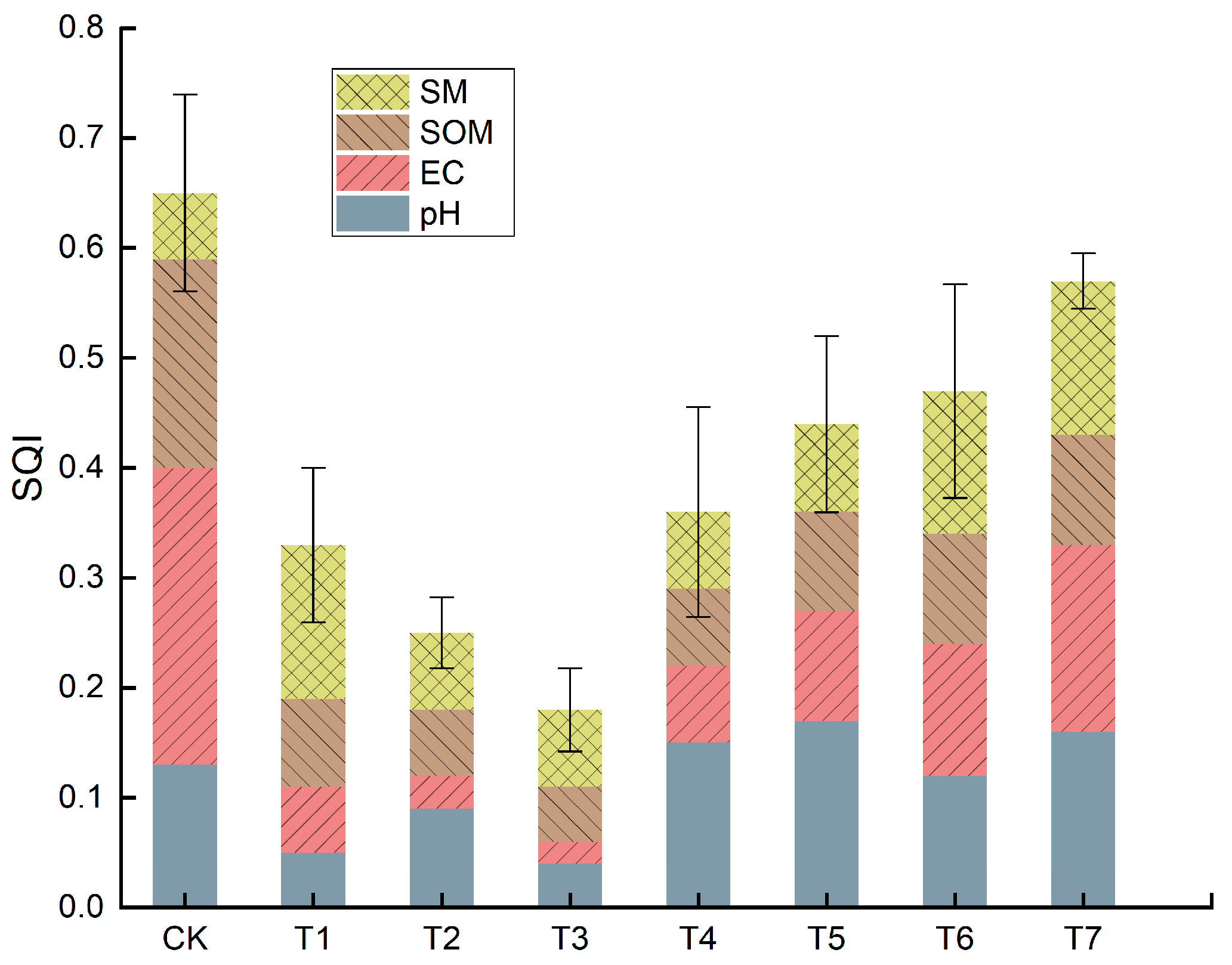
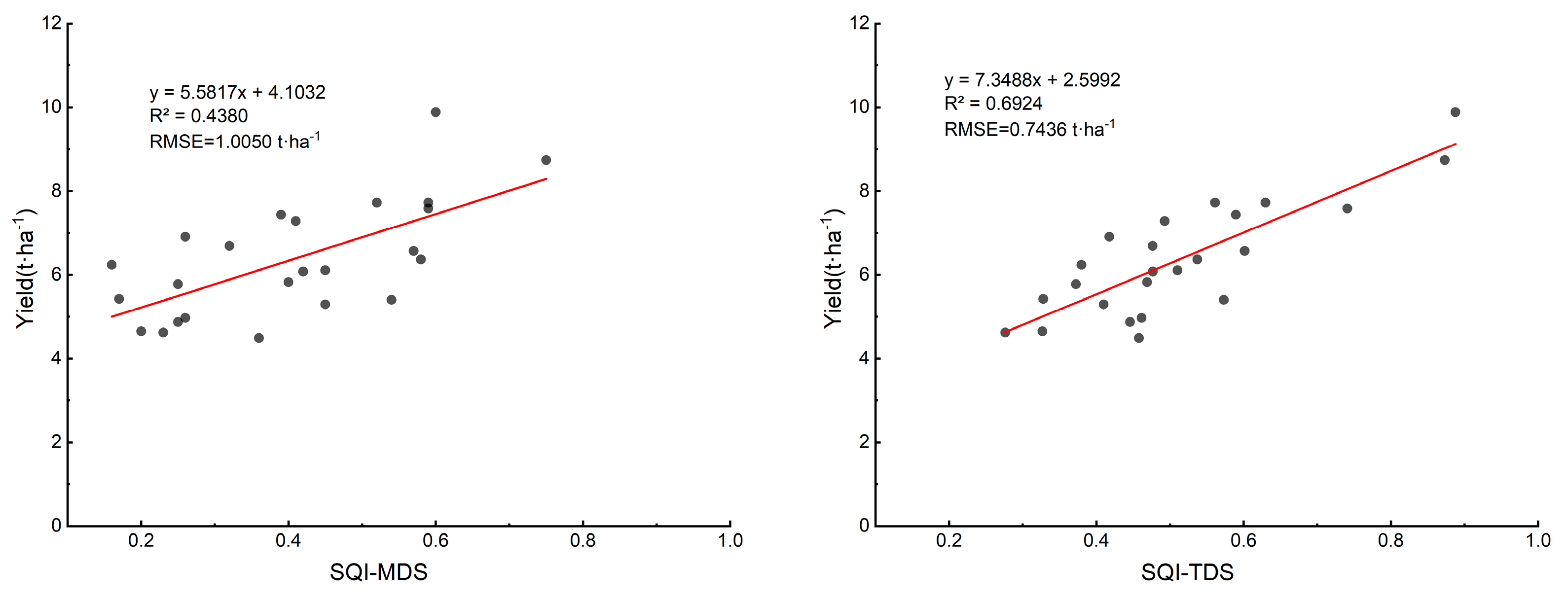
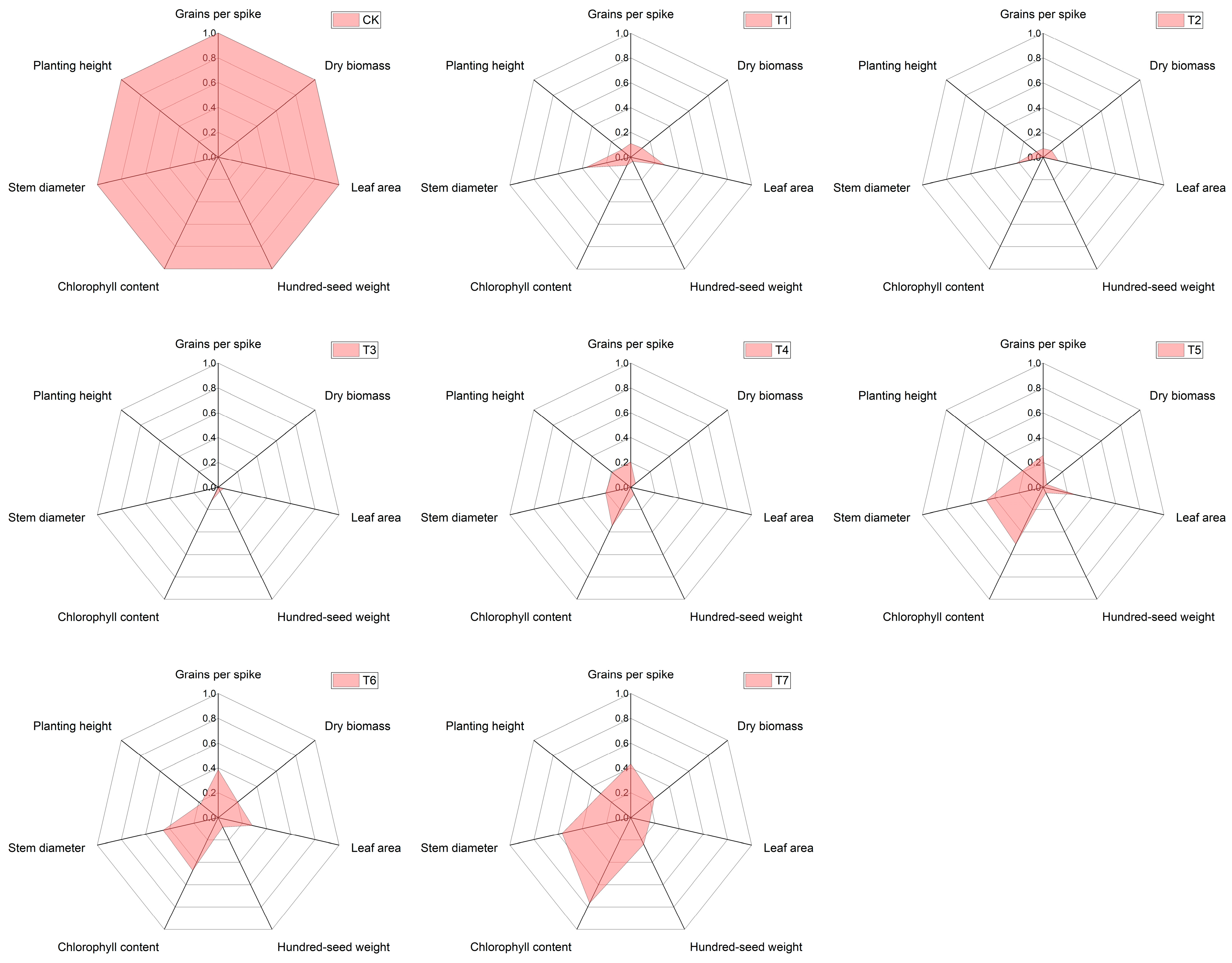
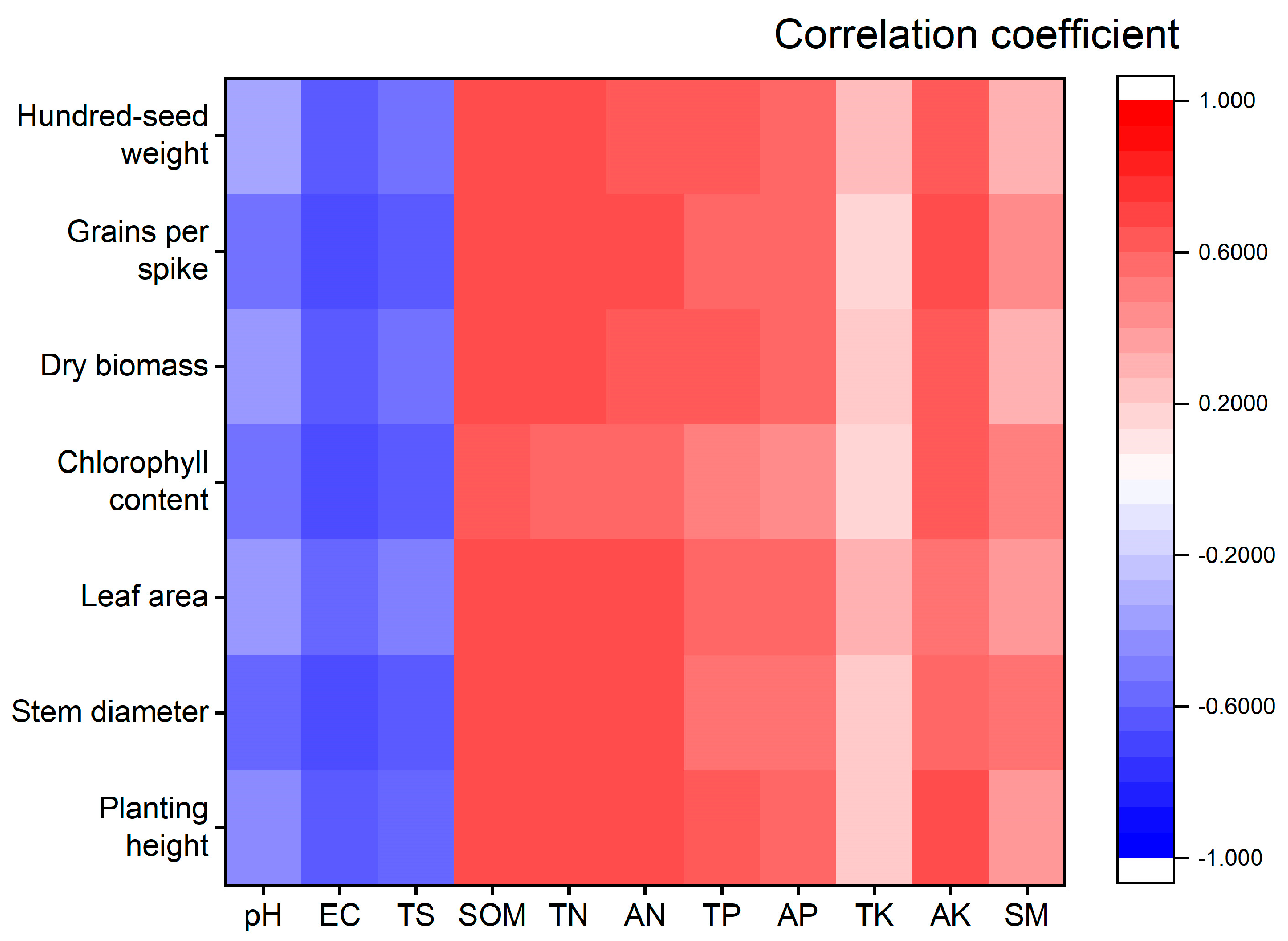
| Properties | Texture | pH | SOM (g/kg) | TN (g/kg) | AN (mg/kg) | TP (g/kg) | AP (mg/kg) | TK (g/kg) | AK (mg/kg) | ||
|---|---|---|---|---|---|---|---|---|---|---|---|
| Sand (%) | Silt (%) | Clay (%) | |||||||||
| Topsoil | 8.35 | 73.98 | 17.67 | 7.62 | 6.99 | 0.71 | 12.56 | 0.16 | 0.88 | 241.1 | 27.93 |
| Subsoil | 9.11 | 74.14 | 16.75 | 7.67 | 5.08 | 0.60 | 13.21 | 0.15 | 1.46 | 247.28 | 46.31 |
| Coal gangue | Gravel | 10.04 | 82.71 | 8.47 | 1.25 | 1.25 | 13.23 | 13.23 | 352.32 | ||
| PC1 | PC2 | PC3 | |
|---|---|---|---|
| Eigenvalue | 6.48 | 2.11 | 1.08 |
| Variance (%) | 58.88 | 19.18 | 9.77 |
| Cumulative (%) | 58.88 | 78.06 | 87.83 |
| Variable | Component Correlation Scores | ||
| pH | −0.37 | 0.85 | −0.08 |
| SM (%) | 0.11 | 0.20 | 0.96 |
| EC (us/cm) | −0.71 | 0.63 | −0.15 |
| TS (g/kg) | −0.67 | 0.67 | −0.12 |
| SOM (g/kg) | 0.94 | 0.02 | −0.09 |
| TN (g/kg) | 0.92 | 0.21 | −0.15 |
| AN (mg/kg) | 0.94 | 0.03 | −0.15 |
| TP (g/kg) | 0.71 | 0.54 | 0.15 |
| AP (mg/kg) | 0.91 | 0.15 | −0.17 |
| TK (g/kg) | 0.74 | 0.29 | 0.11 |
| AK (mg/kg) | 0.93 | 0.23 | 0.01 |
| Variable | pH | SM | EC | TS | SOM | TN | AN | TP | AP | TK | AK |
|---|---|---|---|---|---|---|---|---|---|---|---|
| pH | |||||||||||
| SM | 0.067 | ||||||||||
| EC | 0.749 ** | −0.074 | |||||||||
| TS | 0.770 ** | −0.052 | 0.909 ** | ||||||||
| SOM | −0.332 * | 0.036 | −0.600 ** | −0.600 ** | |||||||
| TN | −0.130 | 0.028 | −0.485 ** | −0.478 ** | 0.876 ** | ||||||
| AN | −0.280 | −0.020 | −0.618 ** | −0.588 ** | 0.887 ** | 0.899 ** | |||||
| TP | 0.120 | 0.287 * | −0.159 | −0.170 | 0.659 ** | 0.729 ** | 0.607 ** | ||||
| AP | −0.209 | 0.002 | −0.510 ** | −0.481 ** | 0.875 ** | 0.909 ** | 0.861 ** | 0.685 ** | |||
| TK | −0.044 | 0.180 | −0.423 ** | −0.246 | 0.677 ** | 0.637 ** | 0.694 ** | 0.628 ** | 0.619 ** | ||
| AK | −0.145 | 0.152 | −0.539 ** | −0.462 ** | 0.863 ** | 0.915 ** | 0.850 ** | 0.781 ** | 0.890 ** | 0.715 ** |
| Soil Properties | Minimum | Maximum | Mean | Optimum | Weight |
|---|---|---|---|---|---|
| pH | 7.21 | 7.83 | 7.51 | 7.4 | 0.250 |
| SM (%) | 23.46 | 27.51 | 25.33 | 25.37 | 0.274 |
| EC (us/cm) | 60.55 | 121.06 | 90.79 | 63 | 0.284 |
| SOM (g/kg) | 3.74 | 6.36 | 4.97 | 6.26 | 0.192 |
Publisher’s Note: MDPI stays neutral with regard to jurisdictional claims in published maps and institutional affiliations. |
© 2021 by the authors. Licensee MDPI, Basel, Switzerland. This article is an open access article distributed under the terms and conditions of the Creative Commons Attribution (CC BY) license (https://creativecommons.org/licenses/by/4.0/).
Share and Cite
Hu, Z.; Liu, S.; Gong, Y. Evaluation of Soil Quality and Maize Growth in Different Profiles of Reclaimed Land with Coal Gangue Filling. Land 2021, 10, 1307. https://doi.org/10.3390/land10121307
Hu Z, Liu S, Gong Y. Evaluation of Soil Quality and Maize Growth in Different Profiles of Reclaimed Land with Coal Gangue Filling. Land. 2021; 10(12):1307. https://doi.org/10.3390/land10121307
Chicago/Turabian StyleHu, Zhenqi, Shuguang Liu, and Yuling Gong. 2021. "Evaluation of Soil Quality and Maize Growth in Different Profiles of Reclaimed Land with Coal Gangue Filling" Land 10, no. 12: 1307. https://doi.org/10.3390/land10121307
APA StyleHu, Z., Liu, S., & Gong, Y. (2021). Evaluation of Soil Quality and Maize Growth in Different Profiles of Reclaimed Land with Coal Gangue Filling. Land, 10(12), 1307. https://doi.org/10.3390/land10121307





